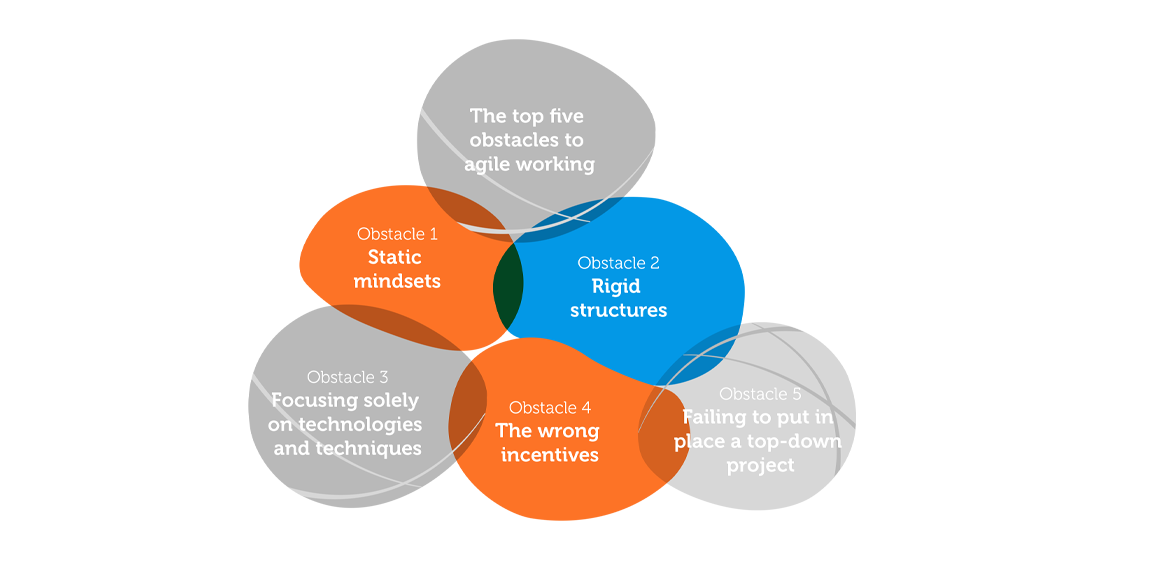The top five obstacles to agile working

Closeness, openness and transparency are the key defining features of agile organizational structures. Agility starts in the mind. Yet acknowledging this and instigating correspondingly far-reaching changes is a mammoth task that many specialists and managers shy away from. Instead, they prefer to limit themselves to introducing agile methods, which they then – rather unimaginatively – present as the cure-all solution.
The top five obstacles
In practice, there is a long list of pitfalls that make it difficult for companies to transform into an agile organization. The top five are:
What does agility mean?
Obstacle 1: Static mindsets
“He who believes he is something has ceased to become something.” This quote from German industrialist Philip Rosenthal meshes perfectly with the concept of agility, which is shaped by post-conventional thinking and is far removed from tradition and dogmatism. As a volatile mindset, agility very much clashes with the attitude taken by many successful business owners who take solace in their routines and improve their products one step at a time. The same can be said for consultants who promote a new method as the one and only solution, not to mention managers who believe agility means being able to do away with rules and regulations. Much more than this, agility means accepting constant change, pursuing a positive error culture, not clinging to old roles and seizing a loss of control as an opportunity – after all, only then is there genuinely scope for innovation.
Obstacle 2: Rigid structures
Silo structures and rigid processes stem agility before it even has a chance to take root. Workspace features such as individual offices and closed doors, reporting structures and legal regulations are just some of the endless examples of organizational routines that have been identified as key obstacles to agility. That is why agile organizations attach importance to inter-departmental cooperation, think through issues such as mobile working and reject the idea of keeping functions strictly separated. In doing so, they move away from a dog-eat-dog mentality and toward a collaborative sense of community.
Obstacle 3: Focusing solely on technologies and techniques
In many cases, it is undoubtedly technology that kick-starts an organization’s digital transformation. In fact, many cutting-edge business models would be unfeasible without it. Yet those who limit agility to a technological transformation will fail to establish an agile organization. An equally ineffective approach is to introduce agile games as isolated measures. Although such techniques certainly generate impetus for agility, taken out of context, they fall short of their intended goals in the medium term. It is therefore imperative to develop a coherent, holistic concept that goes beyond the technical and methodological transformation.
Obstacle 4: The wrong incentives
Incentive schemes are intended to motivate specialist workers and managers to improve their performance. But conventional KPIs are not always effective in creating a team spirit or promoting agile working. Staff who are rewarded only for visible successes may well cease to think outside the box or explore uncertain terrain because they fear there’s too great a risk they will miss out on a bonus. This isn’t to say that incentive schemes are outdated, but it is vital to consider how they can be flexibly designed and what conditions can ensure a quick reaction to market trends.
Obstacle 5: Failing to put in place a top-down project
Most businesses have a structured hierarchy, and it isn’t unusual for this to be accompanied by a culture dominated by anxiety that makes agile thinking and practices impossible. It takes a visionary from as high up in the hierarchy as possible to ensure the company’s shared values change and a culture of trust and dialog can develop. Only if this person implements the project from the top down can control evolve into trust, strict boundaries into collaboration and accountability into autonomy.
Conclusion
Agility can develop wherever day-to-day work is shaped by a volatile mindset, inter-departmental collaboration and a culture of trust. By combining all this with a coherent holistic concept and carefully planned incentive schemes, organizations create the perfect conditions for fully harnessing their innovative potential.
Yet many companies are still pursuing a bogus form of agility, as being open to how a project will evolve does not mean having nothing to show for all your efforts at the end. Agility is much more about viewing errors as part of the process to ensure a problem can ultimately be solved in the best way possible – even if that means doing things differently than originally expected.





